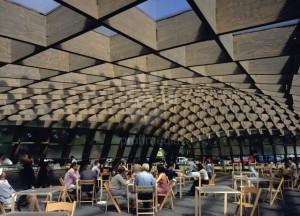
This year’s Venice Biennale of Architecture, called Common Ground has drawn attention not only through its various exhibits but also in regards to the critical writings surrounding the show.
Exhibition director and British architect David Chipperfield had chosen the title Common Ground as a means of addressing the “apparent lack of understanding that exists between the profession and society.” Even with a broad-based title, this latest Biennale may mark a turning point after a period of exhibitions focusing on celebrated designers and showpiece buildings. Furthermore, the decision to award Portuguese architect Álvaro Siza Vieira its lifetime achievement award could be pointing to a philosophical shift for the Biennale of Architecture.
Website ArchDaily has explored in recent articles whether this year’s Biennale was one of the most political in recent memory, questioning the current purpose of architecture, the role of the architect and whether the exhibition was, in fact, too political. Some writers saw particular exhibits engaging with broader issues such as “urbanism, public space, social responsibility and collaboration.” Others felt that as ambitious as these attempts to engage with the socio-political were, the show failed to completely move away from celebrating the designers. Do these themes coalesce when considering the work of Siza, this year’s Golden Lion winner?
Siza was born in the Portuguese town of Matosinhos, near Porto and attended architecture school at the Universidade de Porto, where he has also taught. Having been a Visiting Professor at various schools in Europe, North and South America, he is noted for his collaborations with architects Fernando Távora and Eduardo Souto de Moura. Siza’s style has been described as “never exactly in or out of fashion” and “characterised by its elemental and poetic qualities.” Although his work seems rooted in Minimalism, it tends to defy any firm stylistic categorization with his consideration of the relationships between the built space and its environments.
Highly regarded in his field, he has received accolades ranging from the Pritzker Prize (1992) to the Royal Gold Medal from the Royal Institute of British Architects (2009) but arguably Siza has not enjoyed quite the same name recognition as designers such as Frank Gehry, Norman Foster or Rem Koolhaas.
Siza has designed cultural institutions such as the Galician Museum of Art, Santiago de Compostela (1994) and pavilions at world expos at Lisbon (1998) and Hannover (2000) as well as the Serpentine Gallery, Hyde Park, London (2005). Yet he has also worked on a number of urban design and social housing projects, such as Quinta da Malagueira, Évora (1977), Wohnhaus Schlesisches Tor, Berlin (1980) and Campo di Marte, Venice (1985). During the 1990s, he was involved with the rebuilding of the structures in Lisbon’s Chiado district that were destroyed by fire in 1988. More recently, he worked to restore Cidade Velha in Cape Verde, now a UNESCO World Heritage site.
If it seems that Siza’s career has appeared paradoxical at times, this hasn’t gone unnoticed by the committee that awarded him the Golden Lion and who described his work as a product from “a mind sophisticatedly exercised by the confidence of knowledge and the wisdom of doubt.”
Although critics may be divided on their critiques of this year’s Venice Biennale of Architecture, the discourse surrounding large-scale architectural exhibitions appears to be changing, with questions of a socio-political nature set to become more prominent.
The Venice Biennale of Architecture runs until November 25.
Leave a Reply
You must be logged in to post a comment.